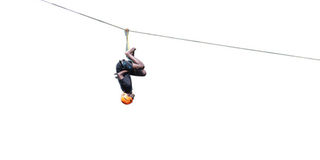Adrenaline rush and enturire at Lake Bunyonyi

Adventure. The zipline above Lake Bunyonyi. PHOTOS BY ROLAND D. NASASIRA.
What you need to know:
FUN. Canoeing, zip lining and rope course in south west Uganda left ROLAND D. NASASIRA awestruck.
On a cold Saturday evening, other 12 travel lovers and I and arrived in Kabale District in for a three-day adventure on Bushara Island on Uganda’s deepest lake in Bunyonyi.
Using a speed engine boat, we set foot on Bushara Island at 7pm. It is approximately three to five kilometres from the mainland, which takes between 15 to 20 minutes. Unlike open lakes, the waters on Lake Bunyonyi are calm because it is surrounded by hills.
The adventure
On a Sunday morning, we start with a nature walk around Bushara Island on a footpath. We go around the island in tall and huge eucalyptus trees. It was a group guided walk without any tour guide. The Bushara Island campsite manager said as long as we followed the footpath, it would lead us back to the starting point. There were no wild animals.
During the two-hour walk, we hear chirping birds, find many tents in a quiet and cool green environments. This is suitable for honeymoon and weekend getaways from the noisy places. The tall trees are for timber harvesting.

Assail
After the walk, we board a boat to sail around the lake guided by Herbert Turyahebwa, a sailor on the lake for 11 years and later turned tour guide. He has done the job for the past eight years.
“Geographically, Lake Bunyonyi is home to 29 islands. One of them is an interesting one named Akampene ( caught our attention),” Turyahebwa says.
He explained that Akampene is the smallest island on Lake Bunyonyi. The name Akampene in Rukiga means “a punishment island”. Akampene was where girls who got pregnant from 1914 to 1946 would be dumped because it was culturally not allowed.
“Among the Bakiga, girls were seen as a source of bride price for their parents. When a girl got pregnant, she would not fetch any bride price for the parents. Girls at that time engaged in sex as a game,” he explains.
“For the local traditional culture to stop the ‘game’, they came up with tough measures and the solution was to drop and abandon girls who became pregnant on the island to die from hunger. This was a warning sign to stop other girls from conceiving,” Turyahebwa recalls.
More than 100 girls were ostracised on the island and their bodies would decompose and be eaten by birds. Akempene is approximately five square metres.
“In 1946, the practice stopped after the arrival of missionaries in Kabale. They (missionaries) came with a teaching to the local community especially parents that when a girl was impregnated, it was not the end of life,” Turyahabwe explains. As you get closer to the island, it is almost submerged. The only two trees left standing on the island are dry and are in the evening of their life.

Happy people. The team sails across Lake Bunyonyi.
Turyahabwe says for a long time, no one has set foot on Akampene Island because it has no docking point for boats. It is believed that in less than five years, the vegetation on the island will have perished.
Activity
On the next day, we had an adrenalin rush rope course and zip lining above the lake at Nature’s Prime Island. It was not something for the faint-hearted, especially if you had phobia for heights.
Each one of us had to be harnessed and hooked on an approximately 500-metre long metallic wire to take you across the lake, before being sent back via a different cable.
Other islands we visited included Kyahugye Eco Resort, Bwama Island and Itambira Island. What more would I wish for!
More fun
Gulimpa Island sits on approximately 20 acres. It is here that we chanced on enturire, a local brew made out of fermented sorghum and honey. There, each one of us was welcomed with a metallic mug, big enough to carry a litre and a half. By the time we left, most cups were half empty.
Our adventure was cut short by the heavy rain, before we sailed to the nearby Sharps Island to take shelter.




